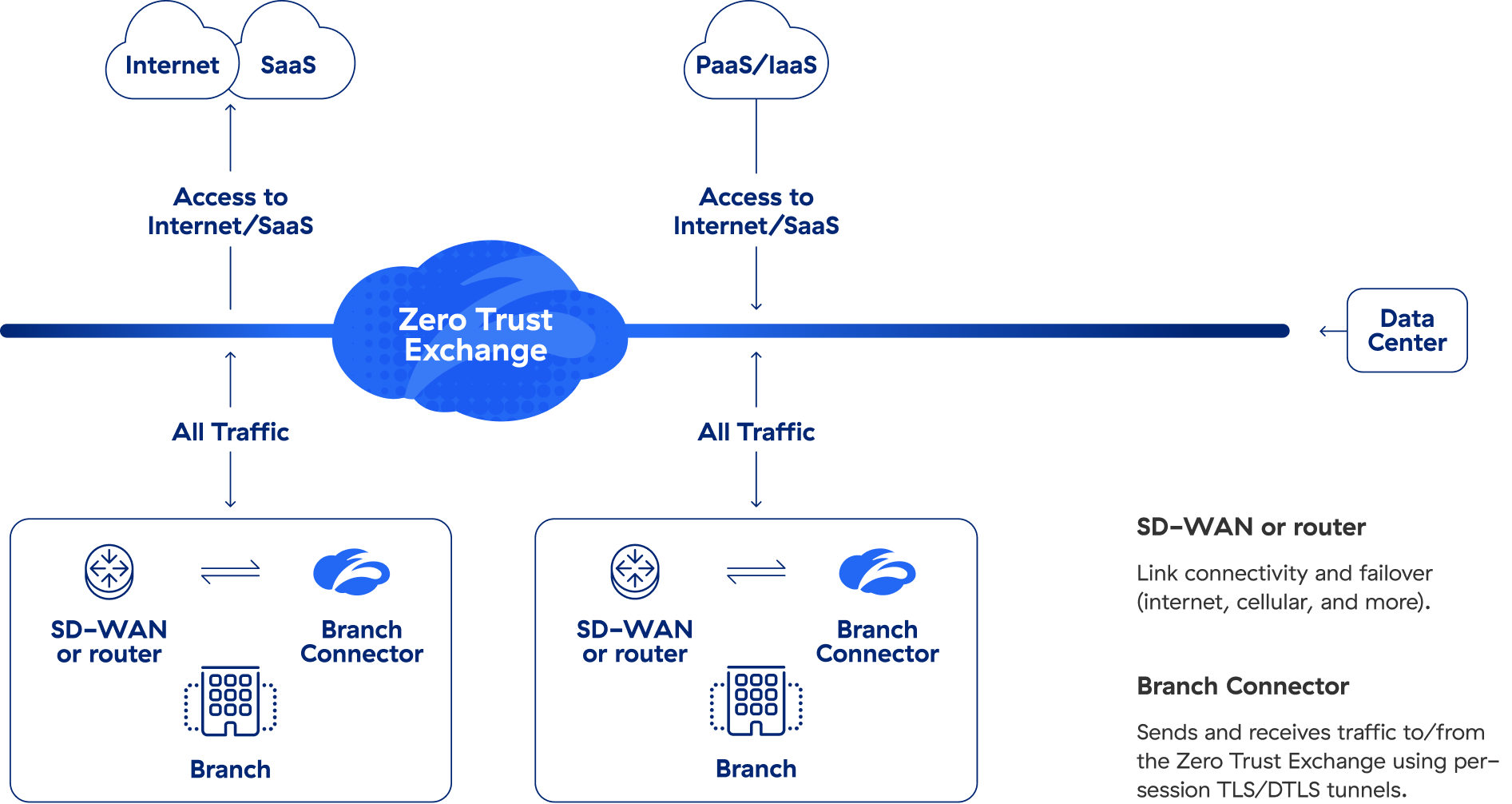/ What’s the Difference Between SD-WAN and MPLS?
What’s the Difference Between SD-WAN and MPLS?
The difference between SD-WAN and MPLS is that SD-WAN is a virtualized network overlay that can combine multiple types of connections, whereas MPLS is a dedicated, hardware-based private network. Furthermore, SD-WAN creates encrypted tunnels over the internet, while MPLS doesn’t directly support encryption but is partitioned from the internet. Today, it’s widely agreed that SD-WAN is more cost-effective, flexible, and secure than MPLS.
What Is SD-WAN?
A software-defined wide area network (SD-WAN) uses virtualization and overlay tunnels to connect users to workloads across multiple transport services and types of existing infrastructure, such as VPNs, broadband internet connections, and LTE, as well as multiprotocol label switching (MPLS) connections. With automated steering to optimize traffic, SD-WAN offers an efficient alternative to traditional WAN connectivity as organizations migrate away from on-premises data centers.
How Does SD-WAN Work?
SD-WAN uses application-aware routing protocols to improve application performance. Most SD-WAN solutions create virtualized overlays in the form of end-to-end encrypted tunnels, through which a centralized manager intelligently steers network traffic on the most efficient route across the WAN. This traffic is prioritized by business policy to offer optimal quality of service (QoS).
These secure tunnels enable users and entities to connect directly to cloud-based software as a service (SaaS) and infrastructure as a service (IaaS), which can lower costs for additional infrastructure, improve connectivity and user experience, and reduce the attack surface compared to a traditional or hybrid WAN architecture.
Learn more in our dedicated article: What Is SD-WAN?
What Is MPLS?
Multiprotocol label switching (MPLS) is a wide area networking protocol that routes traffic using labels instead of IP addresses to determine the shortest path for packet forwarding. It labels each data packet and controls the path it follows, rather than sending it from router to router through packet switching. It’s intended to minimize router latency, improve QoS, minimize jitter, and reduce packet loss while moving traffic as quickly as possible.
How Does MPLS Work?
MPLS functionality makes routers behave more like switches by giving traffic a predetermined path to take based on labels instead of IP addresses. With traditional IP routing, each router makes independent decisions about which next hop to send the traffic toward. MPLS instead sends traffic through a predetermined label-switched path (LSP), and routers only need to interpret the MPLS labels of traffic, not the full IP address.
MPLS routers label incoming or outgoing data and combine packets with similar characteristics so they can be sent down the same LSP after being given the same label. In a corporate context, this can greatly reduce the types of traffic on a network layer, which helps reduce latency.
MPLS can also help partition a network into multiple logical private networks with overlapping IP addresses. This allows large service providers to carry managed WAN traffic for multiple enterprise customers over the same network.
Learn more in our dedicated article: What Is MPLS?
SD-WAN vs. MPLS
An MPLS network can provide performance and QoS advantages, but it requires either a purpose-built network or a managed WAN service. SD-WAN allows enterprises to use any network, including broadband internet, and software-defined policies to select the best path to route traffic to public websites, cloud applications, and data centers. This makes it more versatile and cost-effective than MPLS technology and useful for modern teleconferencing and VoIP, business intelligence, and other real-time applications.
SD-WAN provides simpler provisioning and an increased breadth of traffic engineering configurations due to its software-defined underpinnings. By that same token, SD-WAN offers much improved security over MPLS: software-defined policies established and enforced via the cloud help you encrypt network traffic wherever it’s coming from or going.
Benefits of SD-WAN Compared to MPLS
SD-WAN can connect users to resources over any combination of connections, whereas MPLS requires a static, dedicated network. This means SD-WAN offers a variety of benefits over MPLS:
- Lower costs: WAN traffic tends to spike as cloud adoption grows, driving up costs—especially if you buy new hardware to accommodate higher bandwidth needs. SD-WAN reduces costs by letting you take advantage of cost-effective options like the public internet, unlike MPLS.
- Greater flexibility: Changes to the virtualized infrastructure of an SD-WAN architecture take just minutes, whereas changes to an MPLS network can take months with all the complexity of managing firewalls and other devices in multiple data centers and branches.
- Higher performance: SD-WAN uses intelligent traffic steering to prioritize critical traffic and creates direct tunnels, which eliminates backhauling, reduces latency, and enhances the user experience. MPLS still needs to reroute all traffic through a central security gateway.
- Greater simplicity: The most advanced SD-WAN solutions feature zero-touch provisioning, removing the need to configure devices ahead of time. ZTP can automatically provision and configure any router in the WAN. MPLS is tethered to hardware, requiring manual configuration.
- Stronger security: SD-WAN tunnels are encrypted end to end and integrate easily with cloud-delivered security functions to protect users and data as part of a SASE architecture. MPLS connections are private but not inherently secure or encrypted, so any data traversing MPLS is vulnerable if the connection is compromised.
Drawbacks of SD-WAN Compared to MPLS
Despite its many benefits, SD-WAN can present certain challenges compared to MPLS, such as dependence on internet circuits, which can increase an organization’s attack surface. To provide truly secure connectivity for users, servers, and IoT/OT devices anywhere while fully realizing the promise of SD-WAN, you need to combine it with an effective zero trust approach.
SD-WAN vs. MPLS Feature Comparison
SD-WAN
MPLS
Network Architecture
Overlay network using any combination of connections
Underlay network using dedicated circuits
Scalability
Highly scalable due to use of existing connections
Limited scalability due to reliance on dedicated infrastructure
Cost
Uses cost-effective broadband internet
Uses expensive dedicated circuits
Traffic Optimization
Intelligent steering, application-aware routing
Limited; must route through central security gateway
Security and Encryption
Built-in capabilities
Requires bolt-on solutions
Deployment and Management
Easy to deploy and configure
Requires expertise to deploy and configure
Redundancy and Failover
Built-in mechanisms
Relies on dedicated backup circuits
Quality of Service (QoS)
Dynamic QoS policies
Static QoS configuration
How Zscaler Can Help
Zscaler combines the advantages of secure SD-WAN with the power of a true zero trust architecture.
Zscaler Zero Trust SD-WAN replaces traditional branch WAN solutions such as MPLS by bringing zero trust principles to every connectivity need—users, servers, and IoT/OT devices. With its direct-to-cloud architecture, the Zscaler Zero Trust Exchange™ eliminates the attack surface and lateral threat movement with a non-routable WAN network.
Zscaler helps you modernize branch and data center connectivity with quicker SaaS and cloud app deployments, local internet breakouts, and no more site-to-site VPNs. With integrated and automated connectivity and security, it reduces complexity and cost and provides a faster, smarter, and more secure alternative to legacy networking technology and security solutions.

Zscaler Zero Trust SD-WAN Use Cases
Enable Direct Internet Access for Branches
On-premises networking and security models become less effective as you migrate apps to the cloud and build cloud native apps. Zero Trust SD-WAN is purpose-built for branch transformation, ushering in a new model where branches communicate securely with any destination, independent of the underlying network.
Replace Site-to-Site VPN
Connecting users directly to private apps by extending your WAN or relying on VPNs will increase your attack surface. Zero Trust SD-WAN hides applications from discovery behind your branches, and the Zero Trust Exchange restricts access to a set of named entities. All entities must pass strict identity, context, and policy checks before they’re allowed access, preventing lateral movement of threats.
Discover and Gain Visibility into Shadow IoT/OT
Your IT team faces blind spots as unsanctioned, undiscoverable devices connect to your branch office networks, increasing your risk around vulnerable devices and broadening your attack surface. Zero Trust SD-WAN identifies and classifies devices to give IT teams deeper visibility into behavior and help define more effective access control policies.
Secure Server and IoT/OT Connectivity with Zero Trust
Your employees, partners, and vendors need to regularly assess certain IoT/OT assets to maximize uptime and avoid disruptions from equipment and process failures. Zero Trust SD-WAN provides fully isolated, clientless remote access to internal remote desktop (RDP) and Secure Shell (SSH) target systems, without any need to install a client on the devices using jump hosts and VPNs.
Support Seamless Mergers and Acquisitions
Merging two separate networks is challenging and time-consuming, with issues like IP overlaps, routing issues, and an enlarged network attack surface. With Zscaler Zero Trust SD-WAN, networks can remain separate, and branch locations in one environment can quickly connect to private applications in another without disruption.




